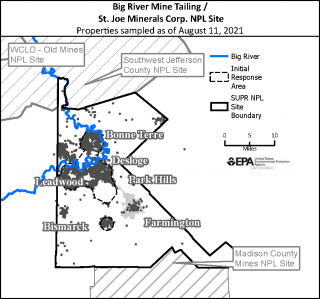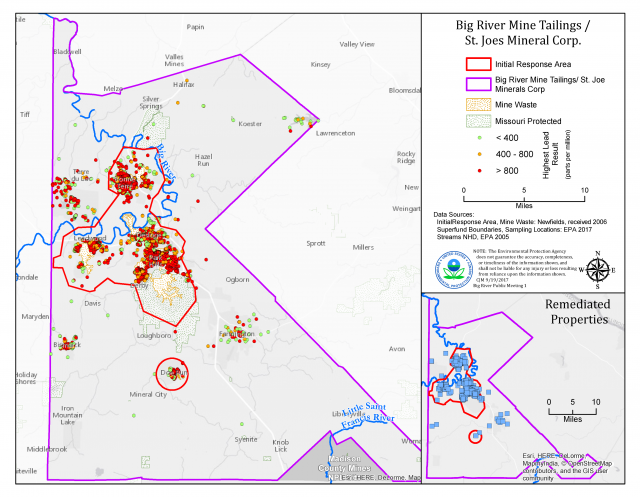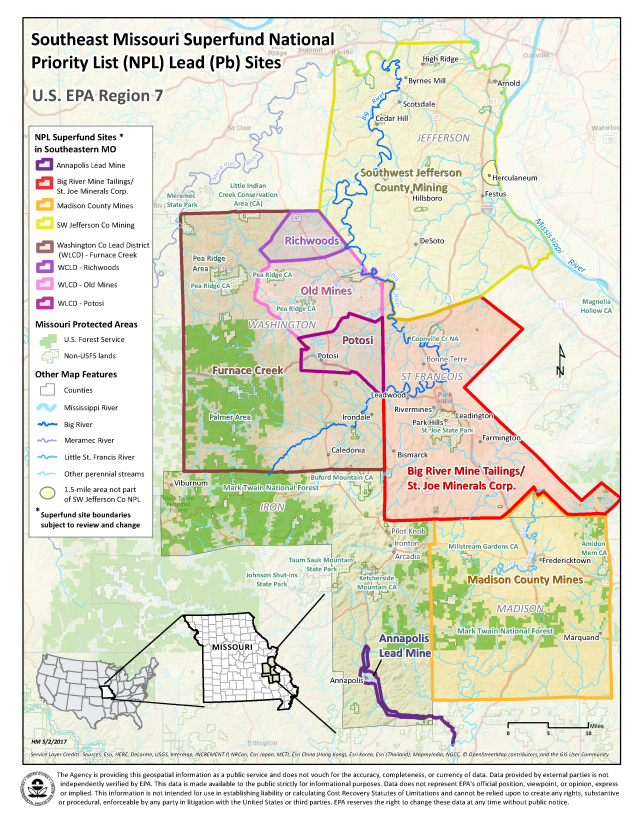Big River Mine Tailings National Priorities List (NPL) Superfund Site, St. Francois County, Missouri - Fact Sheet, August 2021
Remedial Action for Residential Soils Update
Overview of Residential Soil Cleanups

The U.S. Environmental Protection Agency (EPA) is remediating (cleaning up) lead-contaminated soil in residential yards within the Big River Mine Tailings (BRMT) National Priorities List (NPL) Superfund Site (site) in St. Francois County, Missouri. Lead is the main contaminant of concern at this site.
Residential Lead Testing and Cleanup
The county map (shown at right and bottom) shows the site boundaries, area of the initial response area, and the more than 5,100 residential properties that have been tested for lead contamination. Over 1,475 residential properties have been cleaned up since work began in 2000. EPA requests that property owners grant access to the EPA contractor to test and/or clean up residential properties for possible lead contamination.
If your property has not been tested, and you would like to have your soil and/or groundwater analyzed, please contact one of the EPA contacts listed on the next page. There is no cost to the property owner. If your residential property qualifies for cleanup, EPA will include an access agreement with your sampling results letter or EPA flyer.
By signing and returning the access agreement, you are taking the first step in the process to allow the EPA contractor to clean up the affected areas of your yard. EPA and a potentially responsible party (PRP), Doe Run, are working with several contractors in the area to remediate lead contamination previously identified. Please contact EPA with any questions or if you’d like an extra copy of your sampling results.
Lead Contamination Health Risks
Lead is a toxic metal that is harmful if inhaled or swallowed. It is classified by EPA as a probable human carcinogen and is a cumulative toxicant.
Lead exposure can pose serious health risks, particularly for young children, pregnant women, and nursing mothers. Children are more sensitive to lead than adults, and can develop lifelong disabilities and problems from lead exposure.
Annual Childhood Lead Testing
Children 7 years old and younger are most at risk from developing health effects from exposure to lead. It is important that children in this age range be tested annually, because lead-poisoned children do not always look or act sick. The only way to know if your child has elevated blood lead levels is to have his or her blood tested. Talk to your pediatrician, general physician, or local health department to learn what you can do and to have your child tested. Your doctor can do a simple blood test to check you or your child for lead exposure. For free lead testing for children, contact the St. Francois County Health Center, 1025 West Main Street, Park Hills, Missouri; or by phone at 573-431-1947.
Background
This site resides within the Old Lead Belt, which was one of the world’s largest lead mining districts where mining began in the early 1700s, having produced more than 9 million tons of lead. (See map at right.)
It has been estimated that some 250 million tons of hazardous mining waste (such as lead mill waste tailings and chat) were produced in the Old Lead Belt from processing lead ore. Mining activities in St. Francois County have contaminated soil, sediment, surface water, and groundwater with elevated levels of heavy metals, primarily lead. Mine waste (chat) has been manually relocated throughout the area as topsoil, fill material, and aggregate for roads, railroads, concrete, and asphalt across the county. Lead mining tailings have also been used for agricultural purposes due to its lime content. Lead mining waste has also been transported downstream by the Big River. EPA and Missouri state agencies have been addressing lead-contaminated soils in this county for over three decades.
Community Involvement
EPA will continue to solicit input from the public during various phases of EPA’s actions at the site, such as provide opportunities for public participation and feedback when EPA publishes a proposed plan for cleaning up the Big River and floodplain. Contact EPA for more information about community involvement, technical assistance opportunities, to receive site updates, or to join EPA’s contact list.
Additional Site and Lead Information
The Administrative Records for the site are available in the online repository at EPA's Site Profile Page (see Site Documents & Data). For technical assistance opportunities and Superfund Technical Assistance Grants, visit EPA's website. Fact Sheets (including site maps) for Missouri Superfund sites are also available online.
EPA Contact Information
- Jason Gunter, Remedial Project Manager; phone: 913-551-7358; email: jason.gunter@epa.gov
- Elizabeth Kramer, Community Involvement Coordinator; phone: 913-551-7186; email: kramer.elizabeth@epa.gov
EPA site contacts can also be reached toll-free at 1-800-223-0425.
11201 Renner Boulevard, Lenexa, KS 66219
Toll-free: 1-800-223-0425
How Would EPA Clean Up My Property?
The EPA contractor will schedule a time to meet with you, review the affected areas of the yard, answer any questions, and address any concerns. The contractor will have a checklist of items to discuss with you, including locating private utilities installed by you at the property and determining the best way to move equipment in and out.

- The EPA contractor will ask you to sign the checklist and give them final permission to start the work.
- Once utilities are located, the cleanup can begin within a few weeks, weather permitting.
- The cleanup generally includes excavating up to 1 foot of soil from the areas that qualify for cleanup. If the property remains above the lead action level at 1 foot of depth, additional soil will be removed until lead concentrations are below the action level or down to 2 feet of depth, whichever comes first.
- The EPA contractor will then replace these areas with clean soil, return the grade to the original contours, and restore the lawn. Note: The EPA contractor is responsible for the maintenance of the property for 120 days (including watering). After the 120-day maintenance period, you are responsible for watering the growing lawn, which may result in additional cost to you on your water bill. This is the only expense you will bear throughout the process. The contractor is only permitted to restore the property to its original condition, and is required to repair or replace any items damaged during the cleanup process.
- Once the restoration work is complete and the yard is established, the EPA contractor will request a final meeting with you to review and sign a final checklist to confirm satisfactory completion.

